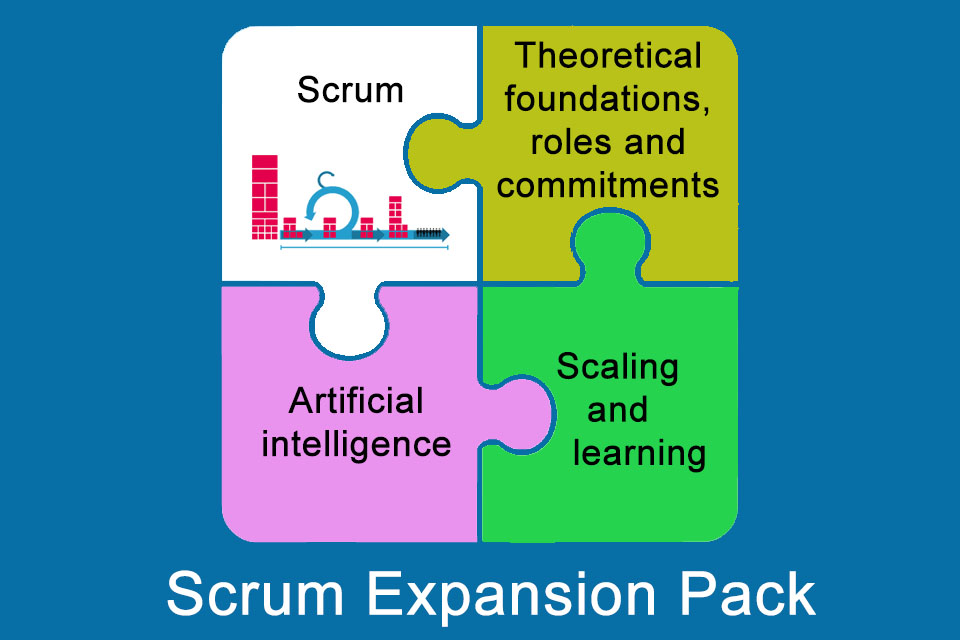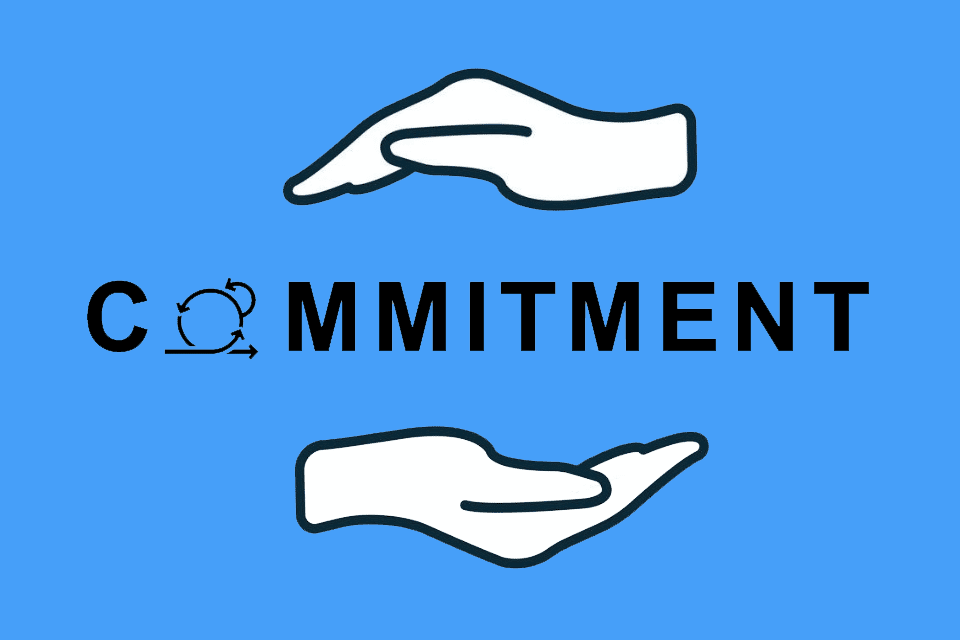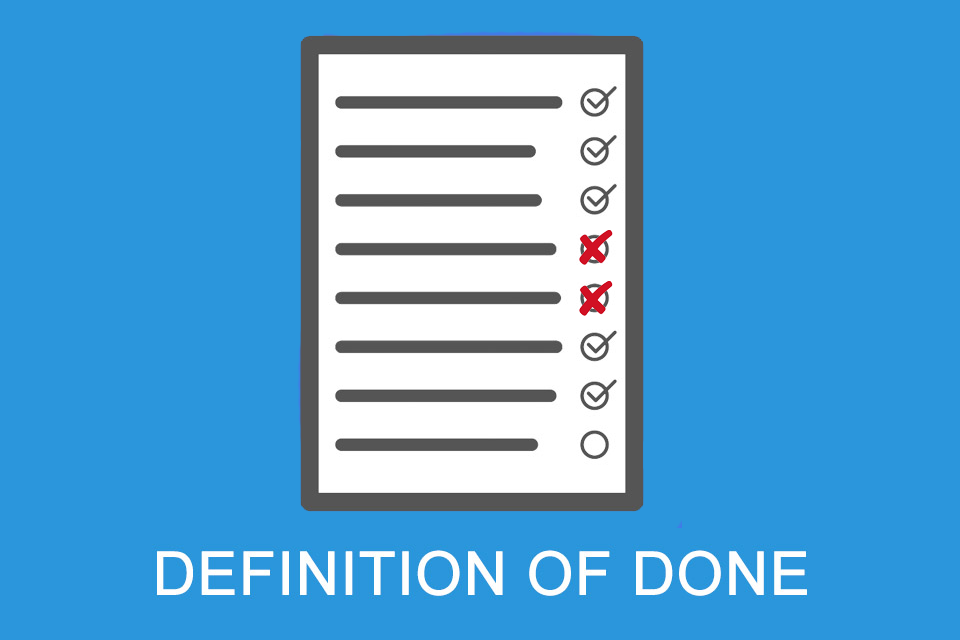What is the Scrum Expansion Pack?
Table of Contents: Definition – Structure and contents – Differences from the Scrum Guide – Foundations, roles and commitments – Questions from the field – Download – Notes
Scrum Expansion Pack – a supplement, not a replacement
There are situations in organisations where the Scrum Guide, with its rules, events, responsibilities and artefacts, offers little practical support. Situations where teams need to better understand theoretical backgrounds and seek concrete examples of complex challenges. Situations where they deal with topics such as scaling, artificial intelligence or systemic thinking. This is precisely when the Scrum Expansion Pack comes into play.
The Scrum Expansion Pack offers experienced Scrum practitioners greater depth and context. Published in June 2025 by Ralph Jocham [1], John Anthony Coleman [2] and Jeff Sutherland [3], the work builds on the well-known principles of the Scrum Guide and supplements them with theoretical foundations, examples and perspectives. [4]
Structure and contents of the Scrum Expansion Pack
Instead of introducing new rules, the Scrum Expansion Pack expands the familiar framework with additional perspectives. It combines theoretical principles with proven practices, creating a deeper understanding of how Scrum works effectively in complex environments. The focus is on the conscious application and further development of principles, not on additional formality.
The Expansion Pack aims to support the use of Scrum in dynamic, often scaled contexts. It describes how teams can deepen empirical learning, systematically improve decisions and shape collaboration across team boundaries. In doing so, it combines thinking models such as empiricism, lean, systemic thinking, the OODA loop and the Cynefin framework with concrete recommendations for everyday use.
In addition to these theoretical foundations, the work provides numerous tips on designing Scrum events, working with product goals and backlogs, and establishing continuous feedback loops. It addresses modern topics such as the integration of artificial intelligence and the collaboration of multiple teams in shared value streams. The Scrum Expansion Pack thus expands the understanding of Scrum as a framework to a learning-oriented system for adaptive product development.
Differences between the Scrum Guide and the Scrum Expansion Pack
Scrum is considered a deliberately minimalist framework. The Scrum Guide defines only the bare essentials: events, responsibilities and artefacts. This reduction has the advantage of universal applicability, but in practice often leaves room for interpretation. The Scrum Expansion Pack fills this gap by deepening principles, explaining contexts and opening up new perspectives on scaling, empirical learning and modern technologies.
| Aspect | Scrum Guide | Scrum Expansion Pack |
| Objective | A minimalist framework for incremental, empirical product development | A practical extension for deepening principles, contextual understanding and application in complex environments |
| Target Audience | Beginners and teams introducing, applying or consolidating Scrum | Experienced practitioners and organisations with advanced Scrum maturity who want to further develop Scrum or use it in complex situations |
| Focus | Normative and simplicity, deliberately open, rule-oriented | Explanatory with a focus on contextual understanding, decision quality and theoretical depth, more interpretative |
| Scope / Level of Detail | 19 pages, compact, considerable scope for interpretation | 50 pages with explanatory sections, models and examples to support application |
| Supporting and Complementary Theory | Implicitly present, hardly implemented | Explicit integration of, for example, empiricism, lean thinking, systemic thinking, the OODA loop and the Cynefin framework as theoretical foundations |
| Accountabilites / Roles | Three accountabilities: Product Owner, Scrum Master, and Developers | Six roles: Product Owner, Scrum Master and Developers. Plus Stakeholders, Supporters and AI. They work together to promote transparency, support and smart decision-making. |
| Artefacts / Commitments | Product backlog with product goal, sprint backlog with sprint goal, increment with definition of done | Added to this are Definition of Outcome Done (for effects), greater emphasis on transparency and feedback loops. |
| Scaling and Multi-Teams | Barely treated | Explicit guidelines for collaboration between multiple teams, shared backlogs and learning structures |
| Artificial Intelligence | Not mentioned | Addresses AI as a supportive responsibility within the team and emphasises ethical use |
The difference between the two works lies not only in their scope, but also in their purpose. The Scrum Guide describes the framework, while the Scrum Expansion Pack deepens understanding. It is aimed at practitioners who have reached the limits of standard application and want to use Scrum more consciously. New responsibilities such as stakeholders, supporters and AIs illustrate that Scrum is increasingly understood as a socio-technical system that integrates people, teams and technologies into shared learning.
Theoretical foundations, roles and commitments in the Scrum Expansion Pack
The Scrum Expansion Pack expands Scrum in three dimensions:
- It deepens the theoretical foundations,
- supplements the familiar responsibilities of the Scrum team with additional roles in the environment, and
- specifies commitments that provide orientation and make effects visible.
The goal is not a different Scrum, but a better understanding of how empirical product development succeeds in complex situations, how responsibility and learning are distributed, and how results become verifiable.
Under the theoretical foundations, the Scrum Expansion Pack first describes supporting and complementary theory. This includes empiricism and lean thinking for evidence-based work and value creation without waste, professionalism as a quality standard, cadence for reliable timing, and concepts such as complexity, emergence and self-managing Scrum teams, which explain working in dynamic environments.
In an extended section, the work introduces further perspectives: product thinking focuses on benefits and results, systems thinking makes interactions visible, discovery strengthens hypothesis formation and validation, leadership describes effective leadership without formal power, first principles thinking sharpens thinking from the ground up, and people and change addresses learning and change in organisations. These fundamentals give teams a common language to better justify decisions and consciously manage adjustments.
In addition to Product Owners, Scrum Masters and Developers, the Scrum Expansion Pack identifies additional roles in the environment. Stakeholders represent affected interests and provide feedback that makes hypotheses testable. The Supporter creates framework conditions, promotes exchange and breaks down barriers without falling into control. The role of AI stands for the conscious use of data-based systems and algorithmic support. It strengthens empiricism, analysis and learning, while humans retain responsibility and judgement. These roles are not part of the Scrum Team, but they increase transparency and learning ability at the interfaces between product, organisation and technology.
In terms of commitments, the Scrum Expansion Pack ties in with the Scrum Guide. Each artefact has a commitment: the product goal for the product backlog, the sprint goal for the sprint backlog and the definition of done for the increment. The Expansion Pack adds a consistent focus on outcomes. It introduces the Definition of Outcome Done, which describes verifiable evidence of achieved impact. While the Definition of Done ensures the quality of an increment, the Definition of Outcome Done clarifies the contribution to the product goal and the actual benefit. Transparency, feedback and learning are emphasised as binding elements so that decisions are traceable, hypotheses remain verifiable and results become visible.
The theoretical foundations strengthen orientation, decision-making quality and outcome focus. They give teams a common language, combine empirical work with professional standards and make adjustments comprehensible.
By the way: OODA Loop and Cynefin support application in uncertain situations as cross-references. OODA Loop helps to quickly observe, orientate, decide and act. Cynefin classifies problem areas according to their complexity and shows which approach makes sense in which context. Both frames of reference complement the fundamentals mentioned here and facilitate context-appropriate implementation.
Questions in the context of Scrum Expansion Pack
Here you will find some questions and answers in the context of the expansion:
What practical examples and tools does the Scrum Expansion Pack contain?
- It shows how teams integrate Scrum into their everyday work, clarify responsibilities, make effective use of AI and collaborate in scaled environments.
- Case studies with typical stumbling blocks provide concrete tips for successful implementation, supplemented by clearly described refinement processes with formats, checklists, and criteria for neatly prepared backlog items.
- For multiple teams, it recommends a common product goal, shared backlog, and coordinated learning cycles.
- Thinking models such as Cynefin and OODA combine empiricism with concrete decision-making paths, while a pattern library supports retrospectives, stakeholder work, product focus and outcome measurement.
- Understanding of product owner responsibility grows through tools for stakeholder management and consistent outcome orientation.
- Guidelines for AI integration show, for example, the generation of test cases and the evaluation of user feedback, supplemented by ethical guidelines and microlearning for Scrum Masters.
- Metrics and flow tools make results visible and learnable in the sprint review.
- Workshop formats and coaching impulses promote psychological safety, a feedback culture and organisational learning. Checklists, canvases, guiding questions and templates such as Definition of Done Canvas, Stakeholder Mapping and Value Stream Analyses facilitate direct application in everyday work.
How does the Empiricism expansion pack implement this in everyday life so that decisions are based on verifiable evidence?
Definition: Knowledge is gained through observation, experimentation and adaptation.
Purpose: Base decisions on verifiable evidence and make assumptions visible.
Practice: Mark hypotheses on product backlog items, define measurable outcome criteria, plan simple experiments, check data in the sprint review, use the definition of outcome done as a reference.
Anti-pattern: Fulfilling a plan instead of learning, evaluating output instead of impact, collecting key figures without gaining insight.
Measurable: Proportion of validated hypotheses per sprint, time to decision based on new evidence, change in relevant target metrics.
How does Lean Thinking in the Scrum Expansion Pack help to focus on value streams and avoid waste?
Definition: Maximise value and reduce waste.
Purpose: Focus attention on flow, bottlenecks and genuine value contributions.
Practice: Value stream analysis before initiatives, limit work in progress, deliver small batches, make queues visible.
Anti-patterns: Local optimisation of individual teams, overproduction, starting without finishing.
Measurable: Lead time, flow efficiency, proportion of unused features.
How does Product Thinking work with a focus on benefits and results?
Definition: Think in terms of the problem and the desired outcome.
Purpose: Prioritise outcomes over outputs and sharpen product goals.
Practice: Formulate product goals in outcome metrics, clarify the problem space before the solution space, document impact hypotheses.
Anti-pattern: Manage backlog as a feature list, define success by quantity rather than utility.
Measurable: Change in usage behaviour, target metrics per product goal, net outcome score.
How does Systems Thinking help to address causes rather than symptoms?
Definition: Recognise interactions and feedback loops within the overall system.
Purpose: Make decisions with an eye to dependencies, side effects and system boundaries.
Practice: Maintain dependency maps, agree on common policies between teams, address systemic blockers.
Anti-patterns: Isolated optimisation, blame game, local relief with global costs.
Measurable: Reduction of systemic blockers, stability of flow and quality across teams.
How does Discovery reduce risk before anything is built?
Definition: Discover and test problems and solutions iteratively.
Purpose: Reduce uncertainty early on and prioritise learning over implementation.
Practice: Plan simple experiments, prototypes and user interviews before development, explicitly test assumptions.
Anti-pattern: Build immediately without evidence, seek confirmation instead of falsification.
Measurable: Proportion of validated ideas before development, learning time until go or stop.
How does the Expansion Pack support sustainable change rather than short-lived introductory waves?
Definition: Understanding change as a learning process involving behaviour, skills and identity.
Purpose: Ensuring adoption and using resistance as a source of information.
Practice: Planning change hypotheses, impact checks in reviews, routines for feedback and strengthening psychological safety.
Anti-pattern: Tool introductions without behavioural change, campaigns without follow-up.
Measurable: Observable behavioural changes per team, participation in learning formats, sustainability of new working methods.
How does the Expansion Pack change the role of the Scrum Master?
The role of the Scrum Master changes quite significantly in the Expansion Pack:
- A ‘servant leader’ becomes a change agent who promotes organisational development even more actively and makes cultural work visible. The work anchors models such as humanocracy, sociocracy and intent-based leadership.
- In addition, the Scrum Master designs the integration of AI into planning, facilitation and communication with stakeholders, pays attention to ethical guidelines and strengthens outcome orientation, professionalism and self-management within the team.
- In multi-team environments, he supports the coordination of several Scrum teams with common product goals and shared learning cycles.
Despite these additions, the core remains the same. The Scrum Master communicates the values, principles and framework of Scrum, coaches teams, supports them in removing impediments where necessary, and ensures that events take place effectively.
In summary, the Scrum Expansion Pack makes the Scrum Master’s responsibilities more comprehensive and demanding. The focus shifts from being a pure process facilitator to being an effective leader for learning, cultural change and the confident use of AI.
What criticism has been levelled at the Scrum Expansion Pack?
Various experts criticise the Scrum Expansion Pack primarily for its scope, complexity and focus. They see a danger that the originally lightweight character of Scrum will be watered down and that agile practice will suffer as a result.
The main criticism is that it is overly complex. The pack brings together models, new roles and concepts in such a dense form that it overwhelms beginners and less mature organisations. Instead of promoting self-organisation, many believe that theory, frameworks and best practices are brought to the fore, causing teams to experience Scrum as a catalogue of guidelines and checklists rather than a framework for thinking.
Additional roles such as often remain unclear in their interaction with familiar responsibilities, creating uncertainty within the organisation.
Another point of criticism is the academic language, which is difficult to access and hinders practical application. Some experts fear that this will result in more bureaucracy and process optimisation than a culture of learning and adaptability. The passages on artificial intelligence are considered by some to be insubstantial and of limited practical use.
In summary, the criticism is that the Expansion Pack moves away from the minimalist core of the Scrum Guide and binds inexperienced teams with too many specifications and models instead of strengthening their agility.
How can the Expansion Pack be integrated into existing Scrum training courses?
- Examples, checklists, templates and canvas tools help teams to understand complex issues in their own environment and develop practical solutions.
- Moderated discussion rounds on responsibilities, theories and AI integration encourage reflection and show different ways of further development and scaling.
- Coaching and advisory units specifically address challenges faced by mature Scrum teams, such as scaling issues, outcome orientation or the use of AI tools.
- Key questions, templates and accompanying materials are also suitable for self-study, enabling participants to independently transfer what they have learned into their everyday work.
Are there certificates for the Scrum Expansion Pack?
Currently, there are no independent, internationally recognised certifications based exclusively on the Scrum Expansion Pack. Although training courses and workshops cover its content, they usually end with established Scrum certifications such as PSM, PSPO or SPS, or with provider- or company-specific certificates of attendance.
The official examinations continue to be based on the Scrum Guide. Some providers integrate content from the Expansion Pack into advanced courses for Scrum Masters, Product Owners and managers without creating their own examination standard.
The Expansion Pack therefore currently serves as a supplement and consolidation, not as an independent basis for examinations or certificates.
Impulse to discuss:
How can the simplicity of Scrum be maintained in practice when complementary theories, new roles and the definition of outcome done are added?
Notes:
If you like the article or would like to discuss it, please feel free to share it in your network. And if you have any comments, please do not hesitate to send us a message.
[1] Ralph Joacham – Co-Autor von Scrum Guide und Scrum Expansion Guide
[2] John Anthony Coleman – Co-Autor von Scrum Expansion Guide und Kanplexity
[3] Jeff Sutherland – Co-Autor von Scrum Guide, Scrum@Scale und Scrum Expansion Guide.
[4] Here you can find the Scrum Expansion Pack for download.
Here you can find a German podcast episode on the topic: Scrum Guide Expansion Pack from the perspective of product owners.
Here you can find a community that discusses the expansion.
And here you will find additional information from our Smartpedia section:




